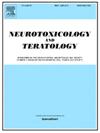孕前和产前大麻和烟草暴露与后代自闭症症状的关系:一项基于人群的纵向研究
IF 2.8
3区 医学
Q3 NEUROSCIENCES
引用次数: 0
摘要
产前接触大麻和烟草与儿童的注意力和行为问题有关,而与自闭症症状的关系尚不清楚。我们前瞻性地研究了父母在怀孕期间使用大麻和烟草是否与儿童自闭症症状有关。通过问卷评估父母使用大麻和烟草的信息,并通过尿液分析检测母亲的大麻代谢物。我们使用两种母亲报告的工具测量自闭症症状:儿童行为检查表(CBCL)在1.5岁,3岁和6岁;6岁时的社会反应量表(SRS) (n = 4380)。线性混合模型用于检查父母大麻和烟草使用与儿童时期CBCL自闭症症状之间的关系。对SRS自闭症症状采用线性回归。母亲在怀孕前使用大麻,而不是在怀孕期间使用大麻,与儿童时期CBCL自闭症症状升高相关(β: 0.33, 95% CI: 0.02, 0.63)。父亲使用大麻与儿童时期较高的CBCL自闭症症状有关(β: 0.27, 95% CI: 0.05, 0.50),这可以用母亲的精神病理学来解释;没有发现与SRS自闭症症状相关。排除大麻使用者,母亲在怀孕期间使用烟草的儿童有更多的SRS自闭症症状(β: 0.03, 95% CI: 0.003, 0.05),而不是CBCL;没有发现与父亲吸烟有关。我们的研究结果表明,母亲和父亲使用大麻与后代自闭症症状无关,尽管孕前使用大麻与儿童时期的自闭症症状有关。相比之下,母亲在怀孕期间继续吸烟与自闭症症状有关,但与父亲吸烟无关,这表明可能是宫内编程,而不是基于家庭的因素。本文章由计算机程序翻译,如有差异,请以英文原文为准。
The association of preconception and prenatal cannabis and tobacco exposure with autism symptoms in offspring: A population-based longitudinal study
Prenatal cannabis and tobacco exposure is associated with attention and behavior problems in children, while associations with autism symptoms remain unclear. We prospectively examined whether parental cannabis and tobacco use during pregnancy were associated with childhood autism symptoms. Information on parental cannabis and tobacco use was assessed using questionnaires, and maternal cannabis metabolites were detected via urinalysis. We measured autistic symptoms using two mother-reported instruments: Child Behavior Checklist (CBCL) at ages 1.5, 3, and 6; and Social Responsiveness Scale (SRS) at 6 years (n = 4380). Linear mixed models were used to examine the association between parental cannabis and tobacco use and CBCL autism symptoms across childhood. Linear regression was used for SRS autism symptoms. Maternal cannabis use before, but not during, pregnancy was associated with higher CBCL autism symptoms across childhood (β: 0.33, 95 % CI: 0.02, 0.63). Paternal cannabis use was linked to higher CBCL autism symptoms across childhood (β: 0.27, 95 % CI: 0.05, 0.50), explained by maternal psychopathology; no association was found with SRS autism symptoms. Excluding cannabis users, children whose mothers used tobacco throughout pregnancy had more SRS autism symptoms (β: 0.03, 95 % CI: 0.003, 0.05), not CBCL; no association was found with paternal tobacco use.
Our results suggest that maternal and paternal cannabis use is not associated with offspring autism symptoms, although preconception use is associated with autism symptoms across childhood. In contrast, maternal continued tobacco use during pregnancy was associated with autism symptoms, but not paternal use, suggesting possible intrauterine programming rather than family-based factors.
求助全文
通过发布文献求助,成功后即可免费获取论文全文。
去求助
来源期刊
CiteScore
5.60
自引率
10.30%
发文量
48
审稿时长
58 days
期刊介绍:
Neurotoxicology and Teratology provides a forum for publishing new information regarding the effects of chemical and physical agents on the developing, adult or aging nervous system. In this context, the fields of neurotoxicology and teratology include studies of agent-induced alterations of nervous system function, with a focus on behavioral outcomes and their underlying physiological and neurochemical mechanisms. The Journal publishes original, peer-reviewed Research Reports of experimental, clinical, and epidemiological studies that address the neurotoxicity and/or functional teratology of pesticides, solvents, heavy metals, nanomaterials, organometals, industrial compounds, mixtures, drugs of abuse, pharmaceuticals, animal and plant toxins, atmospheric reaction products, and physical agents such as radiation and noise. These reports include traditional mammalian neurotoxicology experiments, human studies, studies using non-mammalian animal models, and mechanistic studies in vivo or in vitro. Special Issues, Reviews, Commentaries, Meeting Reports, and Symposium Papers provide timely updates on areas that have reached a critical point of synthesis, on aspects of a scientific field undergoing rapid change, or on areas that present special methodological or interpretive problems. Theoretical Articles address concepts and potential mechanisms underlying actions of agents of interest in the nervous system. The Journal also publishes Brief Communications that concisely describe a new method, technique, apparatus, or experimental result.

 求助内容:
求助内容: 应助结果提醒方式:
应助结果提醒方式:


